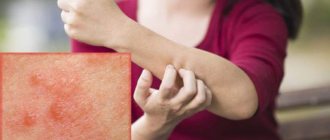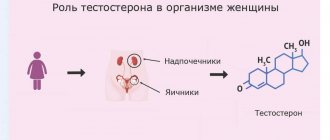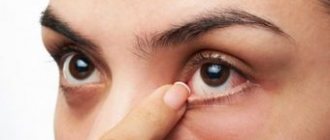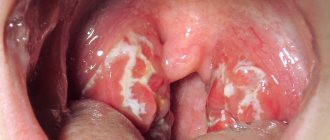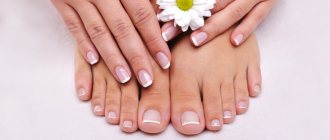This article was prepared by our beloved partners - the #GMfood - an online store of superfoods and craft eco-products.
Just for registering in the store you will receive 300 rubles to your personal bonus account and 2 more interesting gifts (Grab your gifts here)In the store's assortment you will find not only superfoods, but also healthy sweets, breakfasts, herbal teas, peanut butter, master classes for body health and facial beauty, and this is only a small part of the goodies and benefits!
Subscribe to Instagram #GMfood using this link and regularly receive new PP recipes with superfoods, see useful guides to the world of proper nutrition, and also look for gifts hidden under the link in the profile!
Nail fungus - what is it?
What is nail fungus, how to get rid of nail fungus, what methods are there for this? You will learn about this by reading the article.
Beautiful, healthy nails attract the attention of others. Their condition can be worsened by a lack of vitamins and other nutrients. But very often the cause of poor nail condition is a fungal infection.
Onychomycosis is a fungal infection of the nail. It is usually caused by dermatophyte fungi.
Source Wikipedia
The reason for the formation of fungus is associated with improper care and characteristics of the profession:
- Frequent wearing of rubber shoes and gloves;
- Work in damp areas;
- Lack of daily hygiene procedures;
- Professional sports;
- Wearing tight shoes made of artificial materials, which create a “greenhouse effect” and interfere with normal air exchange.
A common cause of fungus formation in women is long-term wearing of gel polish. A closed space is created between the coating and the nail plate, where a fungal infection develops.
Signs of trichophytosis
Perhaps the most severe type of mycosis of the scalp is in the hair growth area, as a result of which the patient loses hair. Differentiate between superficial and deep forms.
With superficial trichophytosis, you can first detect flaky lesions and brittle hair at the base of the follicles, as a result of which the scalp is covered with black dots. On the remainder of the hair after breaking, you can notice a gray coating. The affected areas may become red, itchy, and swollen.
The deep form manifests itself as general malaise, hyperthermia; an infected person may notice swelling and tenderness of the lymph nodes, and a rash. Pink-red spots can be found on the scalp, rising above the surface of the epidermis. They have clear contours and a round shape. The most abundant peeling is observed along the contour of the spot. Less commonly, vesicles (bubbles with liquid) can form along the contour. Such lesions spread quite quickly, which is highly likely to lead to an abscess.
Treatment of nail fungus
Uncomplicated fungus is treated with tablets, ointments, and special solutions.
The most commonly used antifungal tablets are:
- Lamisil;
- Fluconazole;
- Ketoconazole;
- Griseofulvin.
The doctor prescribes them individually for each patient.
Drugs that destroy pathogenic fungal flora and relieve symptoms:
- Nizoral cream;
- Lamisil ointment;
- Mycozoral ointment;
- Lac Loceryl;
- Solutions for treating nails – Creolin, Fukortsin.
At the initial stages, in combination with the prescribed therapy, you can use a patch: Salipod, Onychoplast, Ureaplast, Mycospor set. They should be used strictly in accordance with the instructions.
In advanced cases, removal of the affected tissue may be necessary.
Treatment lasts a long time - from 3 months to a year, since the infection persists inside the nail and you have to wait until it is completely renewed.
When you can do without a doctor and chemistry
Dermatologists emphasize to patients that advanced onychomycosis can be treated only under the supervision of a doctor. Long-term complex therapy will be required, with the prescription of tablets and external agents. Self-medication is only permissible in the early stages of nail fungus development. You can distinguish a progressive mycosis from one that has just begun by symptoms:
- color - after infection with a fungus, the plate at the end becomes cloudy, whitish or slightly yellowish, spots may appear; in advanced cases, the entire nail becomes gray-yellow, greenish or brown;
- structure – in the first stages of onychomycosis, the structure of the nail plate does not change significantly; as it progresses, the nail becomes very thick, splits, becomes loose, and crumbles;
- the condition of the skin around – at the beginning of the disease does not change, in the later stages dryness, soreness, cracks, hangnails appear;
- sensations are absent; if the skin is damaged, itching, pain, and general discomfort appear.
Home remedies can only be used in the early stages of onychomycosis. You can cure yourself if no more than 3 nails are affected, less than 2/3 of the area is affected, there is no severe hyperkeratosis, and the skin is not involved in the pathological process. With extensive changes in the nail plates, a course of complex therapy will be required, lasting from 3 to 12 months.
There are no foods that can kill fungi from the inside of the body. Homemade mixtures have a fungistatic effect - they slow down the growth and reproduction of fungal microorganisms. They prevent infection from spreading to the growing nail.
Prevention
To protect yourself from infection, you must:
- Use medical disinfectants with the inscription GOST;
- Keep your feet and nails clean;
- Take care of shoes, dry them, disinfect them;
- If your feet sweat a lot, treat them with antiperspirants;
- Wear comfortable shoes made from natural, breathable materials;
- In the sauna, swimming pool, gym locker room, wear rubber slippers;
- Do not use manicure tools, shoes or towels from strangers.
Main symptoms of seborrhea
This fungus can be localized not only on the scalp, but also in the area of the eyebrows, mustache, and beard. Develops against the background of disruption of the sebaceous glands. If fat is produced excessively, we are talking about oily seborrhea. If, on the contrary, there is not enough fat, then dry seborrhea. An inflamed sebaceous gland can become infected, for example, with staphylococci, which live on the skin of 90% of people, resulting in fester in the deeper layers of the skin.
A characteristic symptom is crusts (the surface layer of the skin cracks and peels off), as well as profuse dandruff. Reddish-pink spots may appear. Patients note a feeling of tight skin and itching when cold water hits the scalp.
Seborrhea most often affects infants and adolescents.
How to get rid of nail fungus with folk remedies
To treat fungus at home, you can use various herbs and essential oils.
You can get rid of fungus using folk remedies:
- Essential oil of lavender and tea tree . Apply the oil to the nail using a cotton swab. It's better to do this before bed
- Soda bath . Soda has an antimicrobial effect, eliminates unpleasant odors, and destroys fungal parasites. In 2 liters of warm water, dilute 2 tbsp. l. soda, stir and keep your feet for 10 - 15 minutes
- Vinegar baths . It is best to do them 3 times a week. Add a glass of 6% vinegar to water heated to 50 degrees. Place hands or feet with damaged nails in the bath and hold for 15 minutes. After that we wipe them dry. We put cotton socks on our feet
- A powerful antiseptic that allows you to destroy fungal flora is iodine . It should be applied to the affected nail 2 times a day.
- A decoction of calamus root is effective . To prepare it, pour 30 g of calamus root with boiling water and place on low heat for 5 minutes. Leave for an hour, then strain. We treat the nail plates with the resulting decoction.
Calamus is a genus of perennial evergreen herbaceous plants. A species of coastal, aquatic and marsh perennial grasses of the Calamus family.
Why home remedies are better than pharmaceutical ones
Traditional methods of treating onychomycosis are based on the use of:
- available food products (garlic, onions, honey);
- popular chemical compounds for household use (vinegar, soda);
- cheap local antiseptics from the pharmacy (peroxide, iodine, alcohol);
- herbal extracts (infusions, essential oils).
All of the listed substances have a high level of safety and are well tolerated when used externally. However, a small risk of individual sensitivity remains. The presence of an allergic reaction can be easily checked by lubricating a small area of skin with the mixture prepared for nails. If itching, burning or swelling occurs, you should stop using the mixture on a regular basis.
Homemade natural medicines have another specific property - they nourish the nail plate and accelerate its growth. This promotes faster growth of the nail and removal of the affected part.
The undeniable advantage of traditional methods is their low cost. Most products and substances are found in every home. If you don’t have them, you can buy them in any store with minimal financial investment.
The disadvantages of homemade medicines for onychomycosis are insignificant - unpleasant odor, staining of nails, time spent on preparing and treating the limbs. Considering that at the end of treatment the patient will experience a complete recovery, the imperfections of traditional methods can be tolerated.
How to get rid of nail fungus at home quickly and effectively
When a fungus appears, every person wants to get rid of it as soon as possible. A person can get sick after one contact with the pathogen, and it will take a long time to get rid of the problem. Therefore, you should be patient and carry out the procedures regularly.
- Before the procedure, steam sore nails;
- To soften, use alkaline compounds. You can add 1 tbsp per liter of water. l. soda;
- Then remove the thickened tissue;
- Use items that have been disinfected after previous treatment or disposable items;
- The temperature of the baths should be 40-50 degrees;
- Exposure time – 15 minutes.
Vinegar
The fungus is destroyed by an acidic environment, so vinegar is widely used for treatment; with its help, you can quickly get rid of the infection, relieve inflammation of the skin, and also restore the structure of the nail.
- For treatment, you need to prepare a vinegar solution in the proportion of 1 part vinegar to 8 water. In this case, the liquid should be at room temperature. Before treatment, feet should be steamed in hot water, and then the affected part of the nails should be removed. Then you should dip your feet in a basin with the prepared vinegar solution for 15 minutes. This procedure is carried out once every two days.
- Another way is to soak clean socks in a vinegar solution, put them on your feet, put woolen socks on top and go to bed like that. In the morning, feet should be rinsed with cool water and dried thoroughly. Clean the softened surface of the nail with a file and treat with an antiseptic solution.
If desired, you can add essential oils to the water, such as peppermint, rosemary, lavender and eucalyptus oil. They have a relaxing, anti-inflammatory and antiseptic effect and allow you to destroy fungal spores in a short time.
Ways to get rid of fungus
You can get rid of fungus using different methods. For this you can use:
Ointment
At home, you can prepare an ointment that contains: vinegar essence, glycerin, olive oil, dimethyl phthalate. We use the ingredients in the following ratio: 70% acetic acid – 2 parts, all the rest – one part each.
Applications
You can make applications. They should be done after washing your feet. Soak the disc in 9% vinegar and place it on the sore nail. You can prepare another composition: mix water, glycerin and vinegar essence in equal parts. We wet the disc and place it on the sore nail.
Onion
You can use onion juice to treat nails affected by fungus. Or you can prepare a paste of onion, garlic and salt, which you apply to the sore nail and leave overnight.
Garlic
Mix garlic juice, water and alcohol in equal proportions and apply to the affected nail 2 times a day for 15 minutes.
Horseradish
Horseradish root gruel is effective. We put it on a disc, bandage it to the nail and leave it overnight.
Essential oils
With essential oils you can do:
- Baths. Add 10 drops of lavender, ylang-ylang, rosemary, and tea tree essential oils to 3 liters of warm water. Place your arms or legs in the bath and hold for 20 minutes;
- Compress. We are preparing the composition. To do this, mix a tablespoon of water with the same amount of essential oil and heat it to 30 degrees. We saturate the disc with the resulting composition and bandage it to the nail for an hour. We cut off the steamed nail and clean it with a file;
- Mix tea tree essential oil with softened soap and rub the resulting mixture into damaged nails 2 times a day.
Propolis
The following recipes with propolis are effective:
- 15 drops of 20% alcohol tincture per bath;
- Solid propolis bandaged to the damaged nail;
- Crushed propolis + pharmacy antifungal cream.
Celandine
We prepare a decoction from celandine. For this, 5 tbsp. l. pour 1.5 liters of boiling water over the roots and leaves of the plant and cook for 12 minutes. We use the resulting decoction for baths.
The best effect in the fight against fungus comes from a combination of medications and folk remedies.
Celandine
I present the treatment of foot fungus with folk remedies with the indispensable help of celandine, which has a general, effective antifungal effect. In the summer, we pick the celandine, at the place of the breakdown the orange juice we need will appear (maybe with a tint). With this same juice, we lubricate all existing sick and affected areas.
You may feel itching at first, but it will certainly begin to gradually disappear. This procedure should be repeated after 3.5 minutes. Thus, we repeat exactly 4 necessary times. It is important to do 2 such cycles during the current day. A month of treatment will bring huge changes and improvements.
Reviews from real people
Is it possible to cure nail fungus? What do people say about this?
Feedback on the forum
Feedback on the forum
Feedback on the forum
Feedback on the forum
Feedback on the forum
Feedback on the forum
Feedback on the forum
Feedback on the forum
Feedback on the forum
Feedback on the forum
There are a lot of reviews. But all people are sure that it is quite possible to cope with the fungus.
